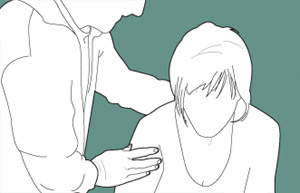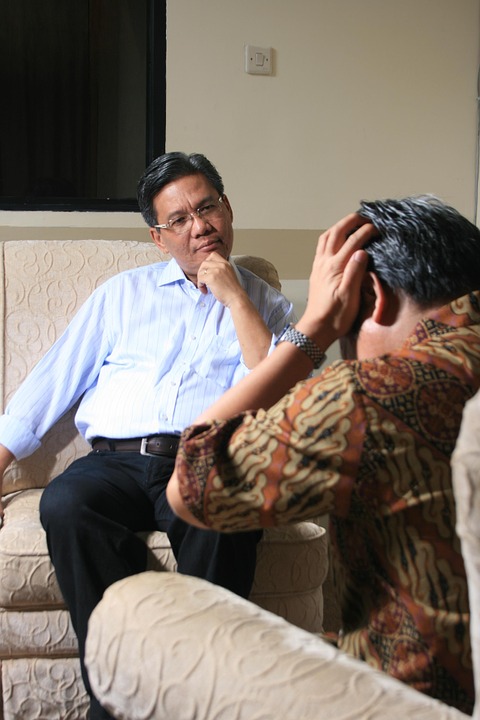Many people with COPD also struggle with anxiety. It's an understandable reaction to the daily worries and hardships of living with a chronic disease. However, for patients who don't find ways to treat their anxiety and manage it in healthy ways, that anxiety can grow to the point that it causes serious problems and affects many aspects of their lives.
One result of this chronic anxiety is panic disorder, or frequent panic attacks. A panic attack is, according to the Mayo Clinic, “a sudden episode of intense fear that triggers severe physical reactions when there is no real danger or apparent cause.”
Although they can be frightening and overwhelming, panic attacks are just that—panic. They aren't actually dangerous or life-threatening, even though they can trick your brain into thinking they are.
However, even though they are harmless in the short term, panic attacks are incredibly unpleasant to experience and can take a serious toll on your mental health. That's why treating anxiety and looking after your mental and emotional health is so important if you have COPD.
COPD patients are more prone to panic attacks for a variety of reasons, and the symptoms of COPD can make them even more difficult to manage and prevent. In this article, we're going to help you understand how panic attacks affect people with COPD and what you can do to recognize, manage, and prevent panic attacks in your own life.
What is a Panic Attack?

Panic attacks are explosive episodes of anxiety that often have no obvious cause. While they usually only last a short period of time—usually about ten minutes—those minutes can be absolutely agonizing.
In fact, the fear and physical symptoms of a panic attack are often so intense that panic attack sufferers believe they are experiencing a life-threatening problem like a heart attack. However, even though the symptoms can be terrifying, panic attacks are almost always harmless.
Panic attacks and panic disorder tend to run in families, and are often triggered by intense anxiety. They are more likely to happen after experiencing stressful or traumatic life events and changes, such as diagnosis of a chronic disease, divorce, or the death of a loved one.
Panic attacks often come suddenly and unexpectedly, and nobody knows exactly why they happen. We do know, however, that panic attacks are inextricably linked with anxiety, and, in at least some cases, are the result of chronic anxiety building up to a breaking point.
The most obvious symptoms of panic attacks include a rapid heartbeat, chest pain, shortness of breath, and intense fear. A panic attack is triggered in part by your body's fight or flight response and is meant to help you respond to real danger. However, when you suffer from anxiety, panic attacks can happen when there is no real threat of danger.
In people who have COPD, panic attacks can happen as a result of health anxiety caused by living with the chronic disease. Episodes of wheezing and shortness of breath caused by COPD can be terrifying, and it's easy to mistake panic attack symptoms for the symptoms of a COPD.
In fact, COPD patients are up to ten times more likely to suffer from panic attacks than people without the disease. And while panic attacks are generally harmless in the immediate term, they can interfere with the treatment and management of COPD symptoms and make your COPD worse if not properly treated.
Here are some of the most common symptoms of a panic attack:
- Rapid, pounding heartbeat
- Shortness of breath
- Dizziness or light-headedness
- Headache
- Nausea
- Sweating
- Chills
- Hot flashes
- Abdominal pain or cramping
- Trembling or shaking
- Tightness in the chest and throat
- Chest pain
- Feelings of dissociation or detachment
- Feelings of fear or terror
- Sense of impending doom
- Fear of death or of going crazy
- Numbness or tingling sensations
The Panic Feedback Loop

A panic attack can start unexpectedly at any time, and it is particularly frightening if you don't recognize it for what it is. Some people in the midst of a panic attack feel as though they are having a heart attack or like they are suffocating and can't breathe.
You might be driving down the road, making a sandwich, or lying in bed when a panic attack hits. They usually come with very little warning, and they can happen frequently or only on rare occassions.
As you can imagine, having COPD can make a panic attack even more frightening, since COPD is life-threatening disease that already makes it difficult to breathe. A panic attack can worsen COPD symptoms like wheezing and shortness of breath, causing even more panic as you struggle to breathe.
Because of this, many COPD patients who experience panic attacks assume that they are experiencing a medical emergency related to their COPD. It can be difficult to tell the difference between COPD symptoms and panic symptoms, which makes panic attacks harder to recognize.
This can cause a panic feedback loop, a downward spiral of anxiety, panic, and breathlessness that can make panic attacks more intense and more frequent. It's a difficult spiral to get out of, and the longer you are stuck in it, the harder it becomes to break free.
Here's what the panic feedback loop looks like:
- You start to feel anxious, fearful, and short of breath.
- When you notice those feelings, it causes you to become even more anxious.
- The increased anxiety triggers and even stronger fight-or-flight response, making the physical and emotional panic attack symptoms even worse.
- The worsened symptoms make you feel even more panicked and anxious, and the cycle continues.
When you're stuck in the panic feedback loop, the only way out is to seize back control over your body and mind. You can do this by using breathing techniques, mental techniques, and therapy to train yourself to respond to react to panic in more healthy, calming ways.
How to Prevent Panic Attacks

At this point, you probably have a much better understanding of the mechanisms behind panic attacks and why they are so problematic for people with COPD. Now, you can build on that understanding by learning new skills and techniques to help you prevent panic attacks and manage them if they come.
Even though COPD symptoms like shortness of breath make panic attacks more likely and more difficult to control, you can still manage them effectively with the right knowledge and skills. If you can learn to recognize a panic attack when one hits, keep yourself calm and collected, and know what treatment options to seek, then you will find it much easier to manage your anxiety and your COPD.
Mind Over Matter
Panic attacks are self-feeding monsters, as we discussed with the panic feed-back loop. If you let fear and panic take over, it will only escalate your symptoms and make the panic attack even worse.
That's why slowing down and taking the time to get your thoughts back under control is one of the most important things you can do to stop a panic attack. It's difficult when you can hardly breathe and your mind is racing, but it's possible if you practice the following strategies:
Separate Yourself from Your Panic

When your heart is pounding and you feel paralyzed by fear, it is difficult to think clearly and rationally. To overcome the chaotic panic, you have to step back from it and find a way to ground yourself in reality.
It can help to remember that the emotions you feel during a panic attack are essentially irrational; they are unnecessary, out-of-proportion feelings triggered by an exhausted brain. When you're in the midst of a panic attack, remind yourself that you're not actually in danger, but simply experiencing a symptom of chronic anxiety.
It may feel like you're dying, or that your world is falling apart, but remember that the feeling is only temporary. Remind yourself that the panic will disappear soon, and even sooner if you can manage to calm yourself down.
Re-frame Your Panic

Instead of fighting against the panic, which can make you feel even more anxious and afraid, try to relax and let it wash over you instead. Remember that you have nothing to fear, that you are simply experiencing the symptoms of a panic attack, and accept the anxiety as an unavoidable symptom.
Although it might seem counter intuitive, struggling against the panic and telling yourself you need to calm down can actually make your panic attack worse. Instead, tell yourself that it's okay to feel anxious, and you will be able to help yourself feel less distressed.
Instead of thinking about the anxiety as a bad thing, re-frame it as something more positive and less scary. For example, you can use the panic attack as an opportunity to learn more about yourself and practice all the healthy coping mechanisms you've learned.
Positive Visualization

Positive visualization is a powerful tool that you can use to calm and redirect your mind away from anxiety and fear. It's basically a way to trick your brain into feeling more calm and letting go of distressing thoughts.
To practice positive visualization, all you have to do is picture yourself in a calm, pleasant, serene environment far away from unpleasant feelings and sensations. You might visualize yourself in a cozy, safe spot in front of a flickering fireplace, or relaxing in a warm, lush field far away from civilization and all of the stressors of modern life.
To be effective, your visualization needs to go beyond a simple image and should engage all of your five senses. Think about what it would actually feel like to be in your calming scene, including what you would hear, touch, smell, and taste if you were actually there.
Visualization can be as simple as taking a few minutes to sit quietly and reflect or as involved as a longer meditation session. For more information on positive visualization and instructions on how to start, you can use this comprehensive guide from the Calm Clinic.
Try the 5-4-3-2-1 Grounding Technique
Panic attacks can be overwhelming, filling your mind with so much fear that it's impossible to think clearly. It can make you feel like you are suffocating, going crazy, or like your life is in immediate danger.
In order to calm down, you need to pull your head out of the panic and convince yourself that you are safe. One way to do this is with the 5-4-3-2-1 grounding technique, a simple exercise you can use to reel in your fear and bring your mind back to the present.
Here's how you do it:
- First you need to pause, take a deep breath, and look around you at your present environment.
- Then, name five objects you can see in the space around you. It could be anything; a chair, a light switch, or a stain on the wall.
- Next, name four things that you can feel or touch around you. For example, you might be able to feel your hair tickling your face, your clothes brushing your skin, or feel the smooth texture of your cell phone with your fingers.
- Name three things that you can hear in your environment (not in your head). You might be able to hear a ticking clock, the whir of air through a vent, or the soft sound of your own breathing.
- Name two things that you can smell. It could be a stale smell of dust in the air, the smell of your perfume or cologne, or the smell of an object in the room.
- Finally, name one thing you can taste, whether it's the neutral taste of your tongue, a strong fragrance in the air, or the remnants of the last thing you ate or drank.
The point of this exercise is to force your brain to focus on what's real instead of the fear inside your head. It can be even more effective if you name the things out loud so you can hear them audibly as recite them in your head.
By forcing yourself to acknowledge the present and the physical environment around you, it's easier to stay calm and grounded. It helps you to convince yourself that you are safe and in no immediate danger in the midst of irrational panic.
Distract Yourself from Your Panic

Finally, once you've reeled in your panic a bit and put things in perspective, you should try to take your mind off of the anxiety. Sometimes, simply distracting your brain from the physical and emotional sensations caused by the panic attack is enough to make the panic subside.
For example, try some simple mental exercises like counting up by multiples of three or reciting the alphabet backward. You can also try reciting a favorite poem, song, or bible passage to help keep your mind busy.
If you have the opportunity, you can also distract your brain with outside stimulation, such as listening to music or watching a video online. Anything that re-focuses your mind on something besides your anxiety can help you regain your sense of calm and control.
Tune in To Your Body

The earlier you can recognize a panic attack, the easier it is stop it. Sometimes you can even feel the signs before the panic hits, but recognizing those signs requires you to pay special attention to your body.
First, study the symptoms of panic attacks until you are confident that you can recognize them. Then, the next time you experience one, pay special attention to how your body feels and how the symptoms manifest for you personally.
Staying tuned in to your body and mind can help you recognize the first signs when something goes wrong. This is not only a way to recognize panic attacks, but also a good general habit to have to look after your mental health.
As soon as you recognize the warning signs or the symptoms of a panic attack, you can then begin to mentally fortify yourself against the panic. You can tell yourself that it is only a panic attack, and use mind-over-matter techniques to keep yourself calm.
Control Your Breathing
The most noticeable and frightening symptoms of panic attacks are the ones that make it difficult to breathe. Shortness of breath, hyperventilating, and light-headedness caused by a panic attack can cause you to panic even more, which only worsens the symptoms further and makes it more difficult to calm down.
This is especially true for people with COPD, who struggle with breathing difficulties on a daily basis. Patients who are already anxious about their life-threatening respiratory disease can easily fall into the panic feedback loop and get caught in the cycle of ever-escalating panic.
That's why one of the most effective things you can do when you're experiencing a panic attack is to get back control over your breathing. It's not always easy to do, but it's almost guaranteed to help you stay calm and make the panic pass sooner.
Rapid, frantic breathing sends panic signals to your brain, while breathing slow and steady signals your brain to calm down. One of the best ways to slow and control your breathing is with a technique called pursed-lips breathing, a common strategy recommended for managing breathlessness for people with COPD.
 |
| Image courtesy of hans van den berg on Flickr. |
ThePursed-Lips Breathing Technique:
- Sit or stand up straight in a comfortable position. Relax your neck, shoulders, and chest.
- Take a deep breath in through your nose lasting about two seconds.
- Purse your lips, as if you were about to blow a kiss, and then breathe out slowly through your mouth for about two seconds (twice as long as the inhale).
- Repeat
Another helpful breathing technique is diaphragmic or abdominal breathing. It helps you learn to breathe with your diaphragm, rather than your chest muscles, which allows you to breathe more deeply and evenly. This not only helps with anxiety, but can also improve COPD symptoms by allowing you to breathe with less energy and strain.

The Diaphragmatic Breathing Technique:
- Lie down flat on your back or sit in a comfortable, upright position. Keep your neck, shoulders, and chest relaxed.
- Place one hand on your chest and one hand on your stomach so you can feel when they rise and fall. The goal of diaphragmatic breathing is to feel your stomach, but not your chest, expand and fall as you breathe in and out.
- Next, take a deep breath in through your nose, using your diaphragm instead of your chest muscles. You should feel the hand on your stomach rise while the hand on your chest stays still.
- Finally, breathe out slowly through your mouth. You should feel the hand on your stomach fall while the hand on your chest doesn't move at all.
- Repeat for several minutes.
Even though it is hard to think straight when you're in the midst of a panic attack, try to remember these simple, easy breathing exercises to help you stay calm. It can help to purposefully practice pursed-lips and diaphragmatic breathing when you're not anxious, that way it will be easier to remember how to do it when you feel panicked.
Do a Relaxing Activity

When you're experiencing a panic attack, it can be difficult to think about anything besides the frightening symptoms and the terror that's taken over your body. But sometimes, giving yourself a positive physical sensation or activity to focus on can take your mind away from your anxiety.
Simple, relaxing activities like reading, doodling, watching a favorite TV show, or coloring in a coloring book help give your hands and your mind something else to do besides focusing on the panic attack. You can also try activities that are tactile or give you a pleasant physical sensation, such as taking a warm shower, wrapping yourself in a soft blanket, or curling up with a hot cup of tea or hot chocolate.
Think Twice About Using Your Bronchodilator Medication
![]()
When you are having trouble breathing during a panic attack, it can be tempting to reach for your inhaler like you do when your COPD symptoms flare up. However, since the breathlessness is caused by panic, not COPD, your bronchodilator is unlikely to be much help.
In fact, bronchodilators act like stimulants and can make the panicked feeling more intense. They can end up increasing your heart rate, cause trembling and shaking, and make you feel even more anxious than you did before.
That's why it's important to learn other calming techniques to help you cope with the symptoms of panic attacks. Try using breathing techniques, meditation, or other relaxation techniques to bring your breathing back under control.
Mindfulness Meditation

Mindfulness meditation is a kind of mental exercise that helps you let go of worry and focus on the present. It's a technique that's highly regarded in the mental health field and is a common treatment recommended to people struggling with anxiety.
To practice mindfulness, you simply sit quietly for a set period of time and try to keep your mind calm and focused on the present moment. Try not to think any conscious thoughts, and let any worries or negative thoughts wash over you like water.
Mindfulness coaches often suggest focusing on your breathing and your body sensations as a way to keep your brain focused on the here and now, instead of what's going on in your head. It's a great way to learn how to stay calm when panic attacks strike and to cope with general breathing problems caused by COPD.
It's often easiest to begin practicing mindfulness meditation by following along with a written or audio-based guide. The University of California, Los Angeles has several free guided meditation audio classes you can use, or you can use the written guide at mindful.org that contains loads of useful tips and advice for getting started.
Seek Emotional Support

When you're in the midst of a panic attack, it can be extremely difficult to think straight, let alone calm yourself down. That's why it can help to call a close friend or family member for support.
It can help to tell your confidant ahead of time about your panic attacks and what they can do to help. Sometimes, just having someone there to ground you in reality and assure you that everything will be okay is enough to make a difference.
In fact, it helps to have someone you can go to for support anytime you feel anxious or depressed, even if it's not a full-blown panic attack. Having someone you can trust and talk to about your feelings is a wonderful form of therapy, and it can help you to begin healing your anxiety, which is the root cause behind most panic attacks.
Another great way to get emotional support is to join a support group for people with anxiety or people with COPD. Group therapy sessions are an opportunity to share your worries, struggles, and successes while learning from others who are facing similar hardships.
See a Therapist

As we've discussed, recurring panic attacks are a strong symptom of a more serious, underlying problem. While you can practice techniques for calming down and reducing your panic attacks in the moment, the only way to prevent them from happening altogether is to take care of the root cause: anxiety.
If you are experiencing frequent panic attacks, then it's important to see a licensed mental health professional who can help you identify and manage the underlying causes. A therapist or psychiatrist can help you learn how to cope and set you on the right path to recovery.
Cognitive behavioral therapy (CBT), in particular, is a research-based therapy that is often recommended for people who suffer from panic attacks. It can help you recognize destructive and unhealthy thought patterns, like those you experience during a panic attack, and change them into something more positive.
CBT can be a very effective way to improve your mental health and alter negative thought patterns that result in anxiety. You can ask your current doctor or therapist about CBT, or find a therapist that specializes in CBT here.
You may also need medication, such as anti-anxiety drugs or antidepressants to help you cope with and recover from chronic anxiety. You can talk to your primary care doctor or a psychiatrist to determine whether or not medication will help and get a prescription if needed.
If you think you are suffering from an underlying anxiety disorder or depression, you should always seek help from a licensed mental health professional. There's no need to suffer in silence, and there are many therapists and psychiatrists who can help.
Putting it All Together: What to Do in the Midst of a Panic Attack

Now that we've shown you a variety of physical techniques, mental exercises, and other strategies for combating panic attacks, it's time to learn how to put it all to practical use. It's all well and good to learn panic-fighting techniques, but it's easy to forget them or dismiss them when the panic actually hits.
That's why you need a comprehensive plan to help you remember how to stay calm and keep you on track even at the height of your panic. You can save the following list of strategies to reference when you experience a panic attack, or write down your own plan with hand-picked strategies that work best for you.
What to Do When You Are Experiencing a Panic Attack:
- Recognize that your symptoms are the result of a panic attack and not an actual emergency.
- Practice pursed-lips breathing to help calm yourself and control symptoms like breathlessness and hyperventilation.
- Use mental strategies to distance yourself from the panic, re-frame your feelings, distract yourself, and visualize calming imagery.
- Find something to do that will take your mind off of the panic attack. Listen to soothing music, try a calming task like coloring, or put your mind to work by counting backwards, reciting a calming mantra, or doing another mental task that keeps your brain busy.
- Call and seek support from a close family member or friend. Having someone to keep you company can help you feel more calm.
- Give yourself permission to take some time out and focus on yourself. Do something you find calming, such as taking a warm shower, practicing yoga, or drinking a hot cup of tea. Self-care is important!
This is not a comprehensive list of strategies, but these techniques should be enough to get you on the way to de-escalating your panic and feeling calm again. Whatever methods you use, don't forget to keep reminders on hand to help you stick to your plan when you're panicked and not thinking straight.


.png)



